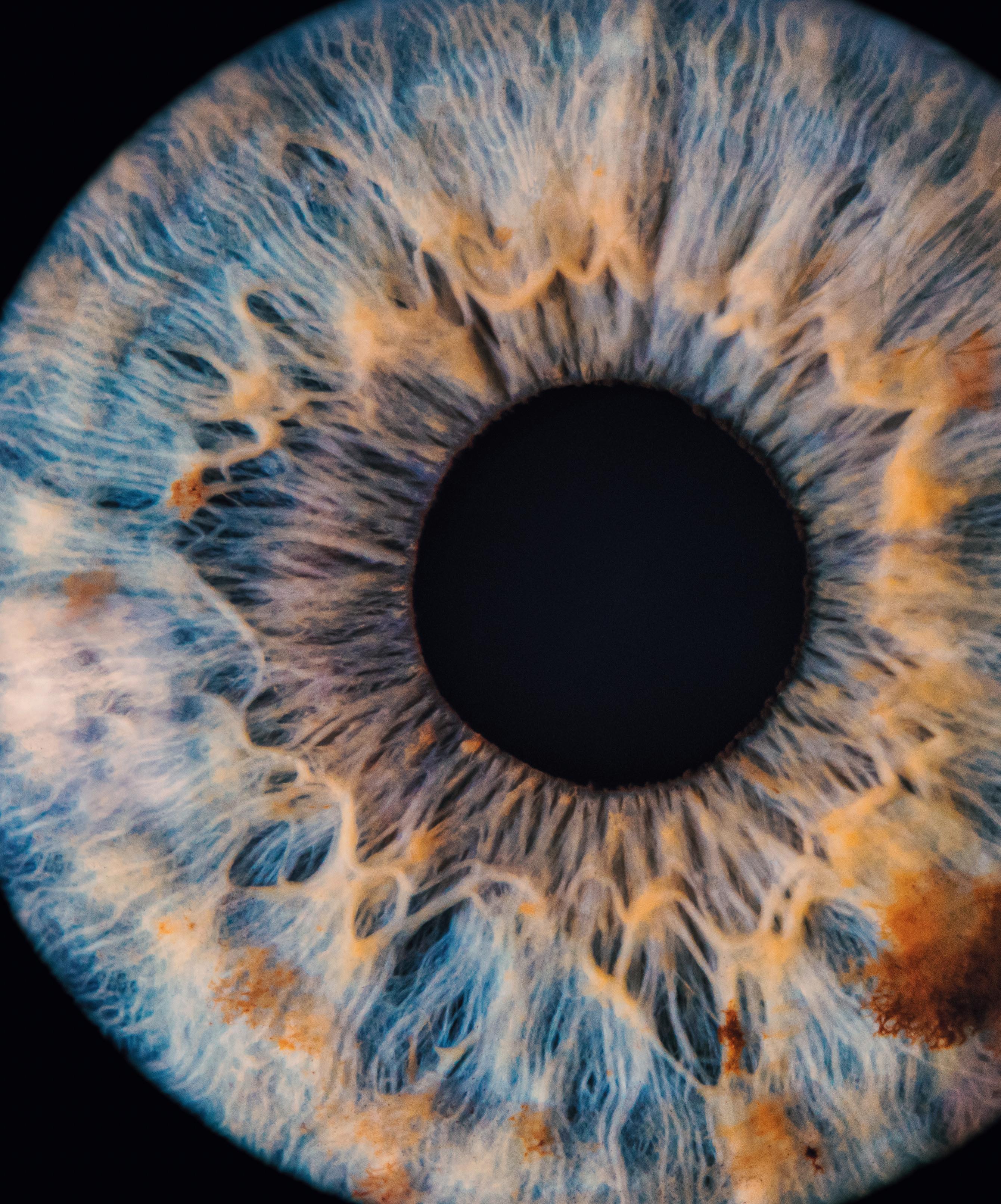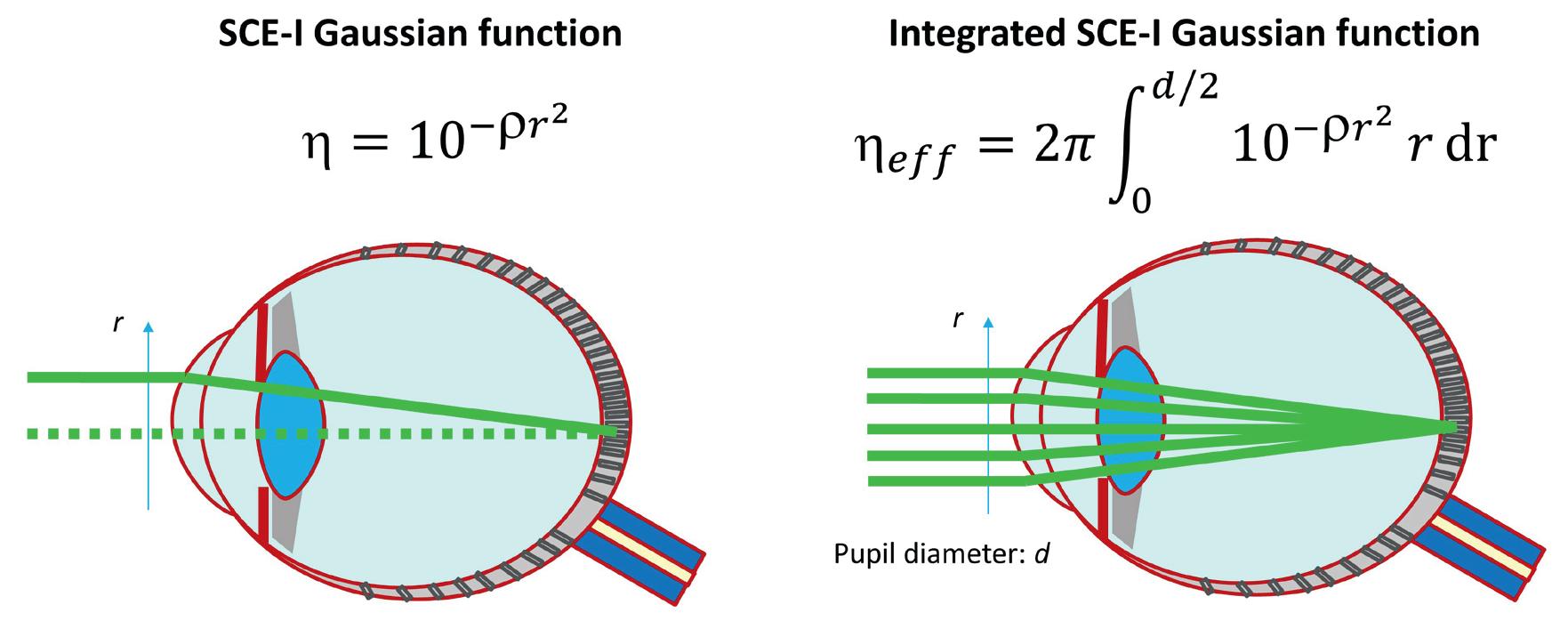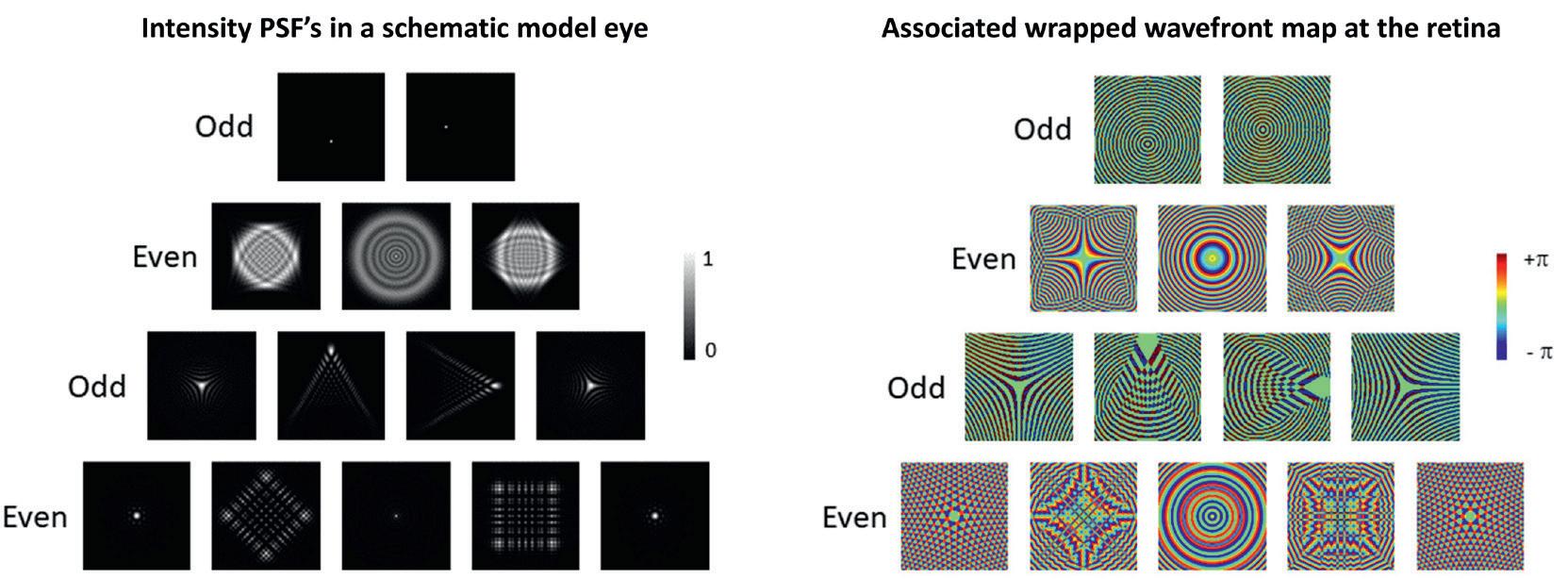
9 minute read
Understanding the visual impact of the Stiles-Crawford effect
The Stiles-Crawford effect (SCE) is a classic of visual optics that remains poorly understood. Discovered by Walter Stanley Stiles and Brian Hewson Crawford in 1932, it is a directional optical effect related to the very elongated shape of photoreceptors. The effect is only observed in photopic conditions and thus it is exclusively a cone photoreceptor effect. It is commonly analyzed for a single pupil point at a time in Maxwellian view corresponding to a single angle of incidence onto the retina. This differs markedly from normal vision through the entire eye pupil. By Brian Vohnsen
Advertisement
The SCE is normally represented as a pupil apodization. Yet, as it originates in the optics of the retina itself, this approach is invalid, and the SCE provides a much stronger apodization than predicted with Maxwellian view. This has direct implications for vision and refractive optics of the anterior eye. In this contribution, the optics of the SCE is described with emphasis on the fact that photoreceptors themselves are active optical elements that impact vision on par with the optics of the anterior eye.
WHAT IS THE STILESCRAWFORD EFFECT?
Vision is highly sensitive to the angle of incidence onto the retina. This is due to the elongated structure of the photoreceptor cells where visual pigment is distributed in densely packed layers within the outer segments of each cell. The common assumption is that they act like optical fibers by guiding light from the inner to the outer segment of each cell. Yet, there are indications that lensing may also be in play in the high refractive index mitochondria that are densely packed in the ellipsoid between the inner and outer photoreceptor segments. The sensitivity to acceptance angle is described by a characteristic Stiles-Crawford function that resembles a Gaussian distribution in the pupil plane. The peak of the function is because photoreceptors point towards a common point near the pupil center whereas the width of the distribution describes the angular sensitivity of the photoreceptors. Thus, if a single ray of light is incident at a pupil eccentricity of 2.5 mm it will dampen the visual response by 50% and at 3.5 mm eccentricity by 75%. WHAT CAUSES IT?
Although clearly of retinal origin, the mechanism causing the Stiles-Crawford effect remains elusive. Photoreceptors are believed to act as biological waveguides due to an elevated refractive index. Yet, vision is only triggered when light is absorbed in the outer segments where visual pigments are stacked and gradually renewed within an approximately two week cycle. Excess light is absorbed by the dark retinal pigment epithelium layer beyond the photoreceptors. That waveguiding is the principal cause of the Stiles-Crawford effect is challenged for a number of reasons: (1) foveal cones that are directional have a similar geometry to that of peripheral rods that lack directionality, (2) waveguiding does not describe what happens with the nonguided light, (3) the short length of outer segments allowing only a single or few reflections that may not build up modes effectively, (4) foveal cones are very densely packed very unlike those of individual optical fibers, and most importantly (5) waveguided oblique light would have a larger optical path

Left: The Stiles-Crawford function of the first kind (SCE-I) is usually expressed by a Gaussian pupil apodization with a characteristic directionality parameter of approximately rho = 0.05/mm2 at the fovea. It expressed the angular acceptance curve for the photoreceptors when measured with Maxwellian light at the pupil. Right: It is common practice to add the SCE-I function point-by-point across the pupil when analyzing its effect for the natural pupil size. Yet, this approach is flawed and severely underestimates its combined effect at the retinal plane. The effective truncation with a natural pupil is nearly an order of magnitude higher than with Maxwellian light.

Left: Light traverses stacked layers of visual pigments in the outer segments. The total absorption is proportional to the volumetric overlap between the light and the outer segments. For oblique light some light will leak into adjacent outer segments that will absorb the light according to the cone type. Right: Cones are either isolated or grouped in small patches within the photoreceptor mosaic, whereas rods are grouped in larger patches with highly similar rods. The larger the patch of identical receptors, the smaller is the effective directionality. The plots show calculated SCE-I visibility curves for individual to larger and larger patches of identical outer segments in a hexagonal photoreceptor array. For rods the SCE-I directionality is practically absent.
The wavefront at the pupil has an accompanying wavefront slope at the retina only for even-order Zernike aberrations. For odd-order Zernike aberrations the point-spread function is similarly degraded, but the wavefront is incident along the axes of the photoreceptors and is therefore not attenuated in the same manner by the SCE-I.

in the outer segments and therefore effective visibility should be larger, not smaller. Thus, I have recently argued that leakage of light rather than waveguiding may be the main reason for the Stiles-Crawford effect. This agrees with other reports of crosstalk between adjacent photoreceptors, but also explains why there is a small hue shift for oblique light (the Stiles-Crawford effect of the second kind) as light leaks into adjacent cones containing a different type of visual pigments (there are three cone types: long wavelength sensitive red cones, medium wavelength sensitive green cones, and a small fraction of short wavelength sensitive blue cones) whereas in the case of rods, any leakage into adjacent rods, will flatten the directionality response.
WHY DOES IT MATTER?
A careful understanding of the optics of the retina and photoreceptors is vital as it is the last optical element of the eye where images projected by the anterior eye trigger a visual sensation. The Stiles-Crawford effect shows that the angle of incident onto the retina is critical for vision. It also differentiates between even (defocus, spherical) and odd (coma, astigmatism, trefoil) Zernike aberration orders as only the former has a wavefront slope in the retinal plane. Additionally, the plasticity of the retinal photoreceptors as being able to readjust to maximize light capture over a period of days suggest that they show a certain degree of phototropism like that of sunflowers. This may help understand visual adaptation as an optical mechanism to improve vision even in cases of blur and scattering of light, and ultimately help understand what optical mechanisms trigger and drive myopia in dim light such as indoors with larger pupil sizes.
HOW DO WE TAKE IT INTO ACCOUNT?
Apodization of the pupil with a Stiles-Crawford effect is only valid on a ray-by-ray basis but not for the combined effect of vision through the natural pupil where its effect is nearly an order of magnitude larger with a drop-off in visibility with pupil size being closer to that of a power law and therefore there is a strong preference for small pupils. The time is due to consider the Stiles-Crawford effect rightfully in the retinal plane as only then can we evaluate its true role in vision. n
Brian Vohnsen, MSc, PhD, is a Fellow of Optica (Optical Society) and Associate Professor in optical physics at University College Dublin (UCD) in Ireland. He received his PhD in NanoOptics at Aalborg University in Denmark. His current research spans from advanced optical imaging techniques and adaptive optics to understanding vision with a special focus on the optics of the retina. He lectures both optics and physics, being twice a winner of the UCD College of Science teaching award and chairs postgraduate programs in physics and the physics committee on equality, diversion and inclusion. Contact: brian.vohnsen@ucd.ie

Larsen Equipment
In 2004, Keith Parker and I opened Advanced Vision Technologies (AVT). At that time, the economy was going through a very bad recession and as a result, it was impossible for a new business starting up to get a loan. We immediately reached out to Erik and Pam at Larsen Equipment to get refurbished equipment to use in our Laboratory. As AVT’s business grew, we invested in many different pieces of new equipment from Larsen Equipment and this helped us grow into one of the Premiere Labs in the United States. Our success is due in part to Erik and his Team with their state-of-the-art equipment and maintenance of their products. AVT is forever grateful for Larsen Equipment’s support of AVT. It is great to know AVT is working with Industry leaders with the Larsen Equipment and their Team! Janine Bungo, Vice President
QUALITY MANAGER: RANDY MINGOY
I have known Erik Larsen since 1992. Since then I have used just about every piece of equipment his company has built. My experience with Erik and the Larsen team has been one of great appreciation as they have always helped me in my needs of fully understanding equipment used to manufacture quality contact lenses. Erik has also been able to engineer any part needed for me even it was a custom part. Erik (Larsen Equipment) has been and still is a pioneer in the contact lens and optical industry, and I am thankful to him for his support over the years.
Randy Mingoy
Quality Manager Advanced Vision Technologies
DIRECTOR OF OPERATIONS: JORDAN GOBEL
There can be a lot of moving parts when it comes to managing operations, so it is key to have reliable precision equipment that assists in overall efficiency. Larsen Equipment delivers just that! I have been utilizing Larsen manufacturing equipment for over 15+ years and have yet to run into an issue they could not resolve. I am a satisfied owner of bladder polishers, edge roller’s and auto-blockers etc. Each one of these units greatly assists in the reduction of rejects and manufacturing waste. Their ability to customize and retrofit specific tools certainly sets them apart from the competition. Larsen stands behind their equipment with a knowledgeable staff that provides exceptional service. Simply put, we are a better laboratory because of our relationship with the folks at Larsen.
Jordan Gobel
Director of Operations/Consultant Advanced Vision Technologies PRESIDENT: KEITH PARKER
I have had the pleasure of working with Erik since the beginning of Larsen Equipment. The first piece of equipment, a 6 spindle horizontal arm polisher revolutionized our production of GP contact lenses. Through the years, I watched his business grow as he and his team listened to our Industry needs and developed now numerous products not only simplifying many tasks of manufacturing but improving the consistency of quality in our finished products. Innovation has been an ongoing experience of our Company only made possible through the innovation of necessary equipment developed and made available by the Larsen team. Larsen Equipment is a family owned business hosting a team of willing Staff all having the attitude of serving their Customer’s needs. As a Customer, we are made to feel like we have a friend in the business helping us develop a more efficient process allowing our Company to deliver better products for our Customers. Our success of AVT simply could not have been possible without the help, assistance and dedication of Larsen Equipment. I will be forever grateful for my opportunity to work with Erik and his very capable Staff.
Keith Parker
President
969 S. Kipling Parkway, Lakewood, CO 80226 Phone: 303-384-1111 888-393-5374 Fax: 303-384-1124 www.AVTLENS.com








